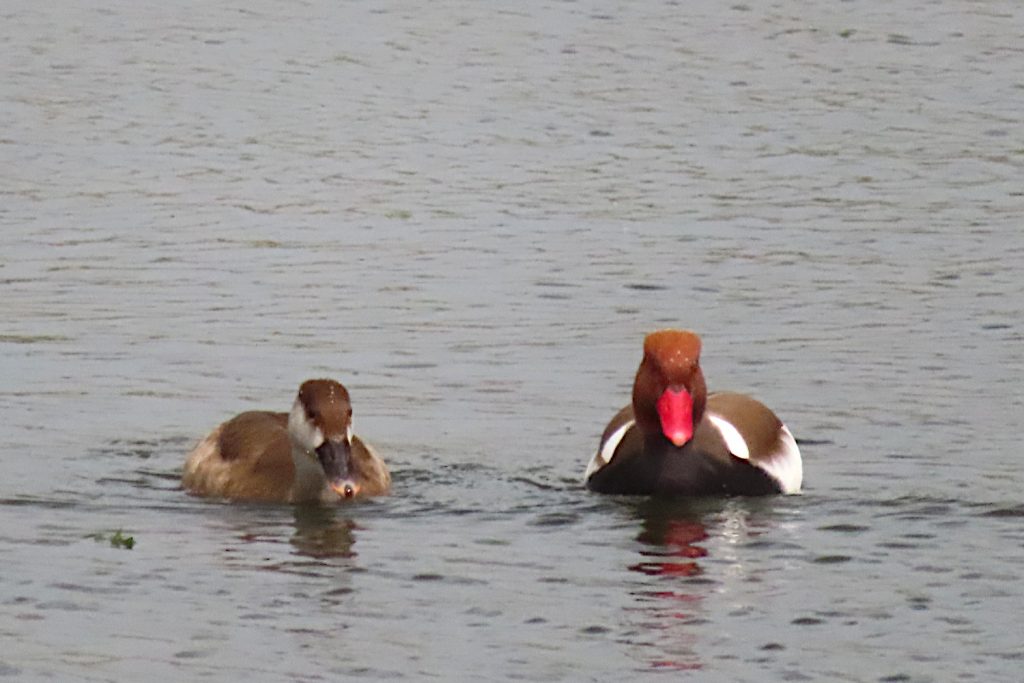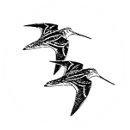Observations

When is a Red-crested Pochard like a Wildebeest?
A summary of the birds of January-February 2025
It was a cold start to 2025 with freezing conditions at the beginning of January. The cold didn’t inspire much movement in the bird world at Rye Meads. It remained cold until mid month and the main change was that our wintering pairs of Stonechat and Shelduck both departed.
Wildfowl numbers were generally low, the highlights being five Wigeon on the January WeBS count and 76 Mallards, noteworthy in this day and age. A Great White Egret also popped in for two January days.
On the raptor front there was a maximum of three Peregrines and a wing-tagged Marsh Harrier.
Following the cold spell, Lapwings rallied once more with regular counts over 200, peaking at 360. A surprise Redshank was presumably re-orienting from somewhere … to somewhere else. Otherwise wader numbers remained low, with 1-2 Green Sandpipers, and a paltry 13 Snipe being the best. New Jack Snipe continued to be found with the thermal imager despite overall numbers located being quite small, the maximum count for the period being seven.
A Barn Owl was roosting out in the meadows as the cold spell commenced but was not seen again, and a female Tawny Owl was heard.
The Magpie roost in the north track peaked at 61, the highest count since January 1992 when 152 were roosting at the washing plant. Other corvid counts included 60 Jackdaws heading south to roost, and 67 Carrion Crows at the works. Two Ravens topped it off, but sadly… no Rooks.
High numbers of wintering warblers continued to be a thing. Chiffchaff counts through January were unexciting until ten were discovered foraging over insect ridden wood chippings over the west side of the South lagoons; numbers then grew to a maximum of 20. Amongst these was a much hoped for Siberian Chiffchaff present for around a week. Blackcaps featured too with a male and a female seen.
Thrush numbers remained low throughout the period, with no more than ten Redwings and still no Fieldfares!
A second short cold spell in mid February gave way to a sudden warming from the south-west, and small signs of birds on the move. A Water Pipit was discovered, remaining to the month’s end, and the same day saw the year’s first Oystercatcher, a trickle of Reed Buntings and 90 Starlings in a tight overhead flock, all heralding change. The first Great Crested Grebe of the year was on No. 2 Lagoon. Two female Stonechats arrived that day too. Tantalisingly, one was wearing a ring – was it one of ours, and if it was, which one exactly? Another evening Starling flock totalled 250, surely birds pausing on their way back east.
Not quite as spectacular as Africa’s annual Wildebeest migration but just as predictable, ten Red-crested Pochards made their adventurous spring journey from Amwell to Rye Meads at the end of this period, a reminder that spring migration isn’t all trans-Saharan!
The only record of Greenfinches in the period was of seven birds, Chaffinches peaked at five and Goldfinches at nine, there were no records at all of Bullfinch, Linnet, Redpoll or Siskin.
Finally, bunting roosts included several counts of 20-40 Yellowhammers, and on one evening a creditable 68 – amazingly, the highest count for 37 years – and a high of 13 Reed Buntings.
For more information on observations and ringing, delivered much more up to date in our bi-monthly Bulletin, why not become a Friend of RMRG?
